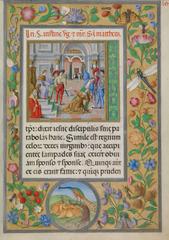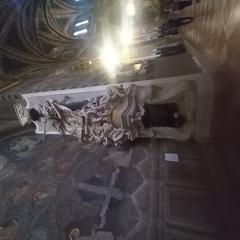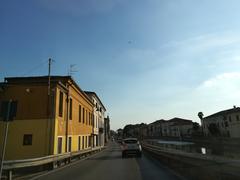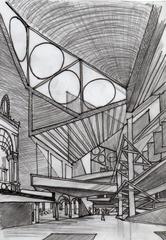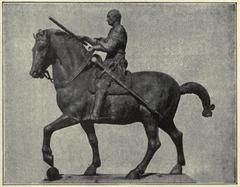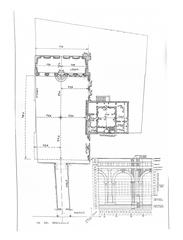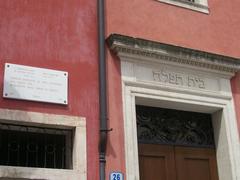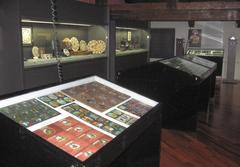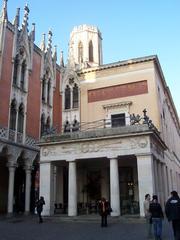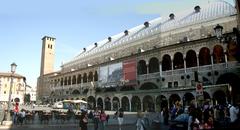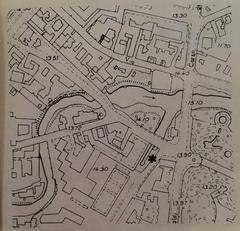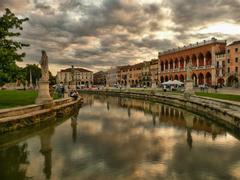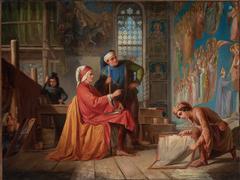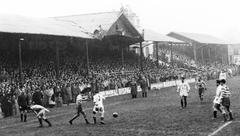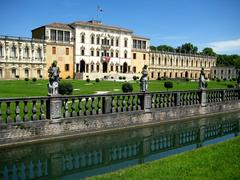
Astronomical Observatory of Padova: Visiting Hours, Tickets, and Historical Significance
Date: 04/07/2025
Introduction
Nestled in the heart of Padua, Italy, the Astronomical Observatory of Padova—commonly known as La Specola—stands as a symbol of scientific progress and architectural ingenuity. Housed in a medieval tower that once formed part of the city’s fortifications, La Specola bridges Padua’s medieval past with its Enlightenment-era embrace of science. Today, it serves as both a museum and an educational center, inviting visitors to explore centuries of astronomical discovery and cultural heritage.
This comprehensive guide covers La Specola’s historical evolution, its pivotal role in astronomical research, practical details about visiting (including hours and ticketing), and tips for making the most of your experience. Whether you are a science enthusiast, a lover of history, or a curious traveler, this article will help you discover the wonders of La Specola.
For further historical and visitor information, see Wikipedia: La Specola, Padua, Astronomical Heritage: La Specola, and the official University of Padua La Specola page.
Table of Contents
- Medieval Origins and Architectural Transformation
- Conversion to an Observatory
- Scientific Contributions and Research Legacy
- Architectural Features and Historical Instruments
- 19th and 20th Century Developments
- Preservation, Museum, and Modern Role
- Practical Visitor Information
- Notable Figures Associated with La Specola
- Frequently Asked Questions (FAQ)
- Conclusion and Visitor Tips
- Sources
Medieval Origins and Architectural Transformation
La Specola’s story begins in the 13th century, when the tower was constructed as part of Padua’s medieval castle under Ezzelino III da Romano. Initially serving as a dungeon, the tower was later heightened and reinforced during the 14th century under the Carraresi family, reflecting its strategic importance in the city’s defenses (Wikipedia: La Specola, Padua). The tower’s transformation from a place of imprisonment to a center of learning is poignantly noted in a Latin inscription added in 1771, which celebrates its new role as a “gateway to the stars.”
Conversion to an Observatory
In 1767, under the auspices of the Republic of Venice and the University of Padua, the medieval tower was converted into an astronomical observatory. This initiative was part of a wider Enlightenment movement to advance scientific observation through purpose-built facilities. The design of La Specola drew inspiration from other European observatories of the period, such as Bologna’s Specola (1712) and Milan’s Brera Observatory (1762) (Astronomical Heritage: La Specola).
By 1777, La Specola featured specially designed observation rooms: the lower Sala Meridiana for solar measurements, and the upper observatory with expansive windows for celestial observation. These adaptations allowed the site to become a hub for astronomical research while preserving its medieval character.
Scientific Contributions and Research Legacy
Early Leadership and Research
Giuseppe Toaldo, La Specola’s first director (1719–1797), established its reputation as a center for meteorological and astronomical data collection. His tenure saw the observatory join international scientific networks, contributing to studies of solar activity, planetary motion, and atmospheric phenomena.
Giovanni Santini (director from 1817 to 1877) further elevated La Specola’s scientific standing through work in celestial mechanics and detailed observations of planetary and cometary orbits (Astronomical Heritage: La Specola).
University Connections
La Specola’s affiliation with the University of Padua, one of Europe’s oldest universities, ensured a steady flow of students and researchers. While Galileo Galilei himself never worked at La Specola, his legacy as a professor at the university (1592–1610) profoundly shaped Padua’s scientific tradition (Astronomical Heritage: University of Padua).
Architectural Features and Historical Instruments
The observatory’s architecture uniquely blends medieval fortification with Enlightenment-era scientific design. The robust stone tower provides the stability needed for precise measurements, while its height offers clear views for astronomical study. Key features include:
- Sala Meridiana: Houses a meridian line for solar observations and timekeeping.
- Upper Observatory: Designed with thick walls and large windows to support powerful telescopes.
- Instrument Collection: Includes meridian circles, refracting telescopes, sextants, quadrants, and astrolabes, illustrating the evolution of astronomical technology (Wikipedia: La Specola, Padua; Live the World).
19th and 20th Century Developments
Throughout the 19th century, La Specola remained at the forefront of astronomical research, participating in international projects such as the Carte du Ciel photographic survey. By the early 20th century, urban growth and light pollution prompted the University of Padua to establish the Asiago Astrophysical Observatory outside the city, which opened in 1942 and became Italy’s leading site for advanced research (Wikipedia: La Specola, Padua; Astronomical Heritage: Asiago). La Specola then transitioned to an educational and historical role.
Preservation, Museum, and Modern Role
Since the late 20th century, La Specola has been carefully restored and expanded as a museum. The Museo dell’Osservatorio Astronomico di Padova, established in 1994, showcases antique instruments, original frescoes, and scientific archives. Today, it is part of the National Institute for Astrophysics (INAF), maintaining its role in public education, outreach, and the preservation of Padua’s scientific legacy (Astronomical Heritage: La Specola; University of Padua La Specola).
Practical Visitor Information
Visiting Hours and Ticketing
- Guided Tours Only: Access to La Specola is available exclusively via guided tours.
- October–April: Saturdays, Sundays, and public holidays, 16:00–17:00.
- May–September: Saturdays, Sundays, and public holidays, 18:00–19:00.
- Special Evening Tours: Fridays at 20:30 in April and May.
- Closed: December 24–26, January 1, May 1.
Ticket Prices (2025):
- Full ticket: €10
- Reduced rates for students, children, and seniors (check official INAF website for current details)
- Free for children under 12
- Group and school rates available with advance booking
Tickets are sold 10 minutes before tours at the nearby Oratorio di San Michele. Advance booking is strongly recommended, especially for groups or peak periods.
Guided Tours and Special Events
Tours last about one hour and are led by expert guides, often astronomers or science communicators. The route includes:
- Inscription Room: 18th-century plaque marking the tower’s transformation
- Column Room: Early observation site
- Meridian Room: Features the meridian line and a quadrant
- Figures Room: Decorated with frescoes of eight notable astronomers
- Rooftop Terrace: Offers panoramic views of Padua
Special events—such as stargazing nights and workshops—are occasionally held in partnership with the University of Padua and INAF.
Accessibility
Due to the tower’s historic structure, there is no elevator and access to upper floors requires climbing approximately 200 steps. Some ground-floor exhibits are accessible, but the site is not suitable for visitors with limited mobility.
Photography and Nearby Attractions
Photography is permitted in most areas, but flash and tripods may be restricted. The rooftop terrace provides excellent views for photos.
Nearby attractions include:
- Prato della Valle (Europe’s largest square)
- University of Padua Botanical Garden (UNESCO World Heritage Site)
- Scrovegni Chapel (famous for its Giotto frescoes)
- Padua Astronomical Clock
Notable Figures Associated with La Specola
- Giuseppe Toaldo (1719–1797): First director, meteorologist, and astronomer
- Giovanni Santini (1786–1877): Long-serving director, expert in celestial mechanics
- Galileo Galilei (1564–1642): Influential professor at the University of Padua, shaping Padua’s scientific legacy (Astronomical Heritage: University of Padua)
Frequently Asked Questions (FAQ)
Q: What are the visiting hours?
A: Guided tours are offered weekends and public holidays (16:00–17:00 in winter, 18:00–19:00 in summer), with special Friday evening tours in spring. Always check the official website for updates.
Q: How do I buy tickets?
A: Tickets are sold 10 minutes before tours at the Oratorio di San Michele. Advance booking via the official website or email is strongly advised.
Q: Is the observatory accessible?
A: Due to 200 steps and no elevator, it is not accessible for visitors with mobility impairments.
Q: Are tours available in English?
A: English tours may be arranged for pre-booked groups; inquire in advance.
Q: Can I take photos inside?
A: Yes, except where restricted (always check with your guide).
Q: What else can I see nearby?
A: Major Padua attractions such as Prato della Valle, the Botanical Garden, and the Scrovegni Chapel are within walking distance.
Conclusion and Visitor Tips
La Specola is a unique testament to Padua’s commitment to scientific discovery, blending medieval architecture with centuries of astronomical research. To make the most of your visit:
- Book your tour in advance, especially during peak seasons.
- Wear comfortable shoes for the stair climb.
- Arrive early, and bring questions for your guide.
- Explore nearby sites to enrich your understanding of Padua’s history.
For a hands-on experience, consider downloading the Audiala app for guided tours and augmented reality features. Stay updated on special events and tours by checking the observatory’s official website.
Sources
- La Specola, Padua, 2024, Wikipedia
- Astronomical Heritage: La Specola, 2024, IAU/UNESCO World Heritage
- University of Padua La Specola page, 2024
- Museo La Specola information, 2024, Live the World
- Visiting the Astronomical Observatory of Padova, 2024, Hotel Giotto
- Things to do in Padua, 2024, The Travel Folk
- INAF Osservatorio Astronomico di Padova official website, 2024
Image suggestions:
- Exterior of La Specola tower (alt: “La Specola Astronomical Observatory in Padua”)
- Sala Meridiana interior with meridian line (alt: “Sala Meridiana at La Specola with meridian line”)
- Panoramic rooftop view (alt: “Panoramic view of Padua from La Specola upper observatory”)
- Historical telescope display (alt: “Historical telescopes at La Specola Observatory”)
Internal links to related articles:
For more tips and the latest updates, follow us on social media and consult our other articles on Padua’s cultural heritage. Embark on a journey through time at La Specola—where history meets the stars.



